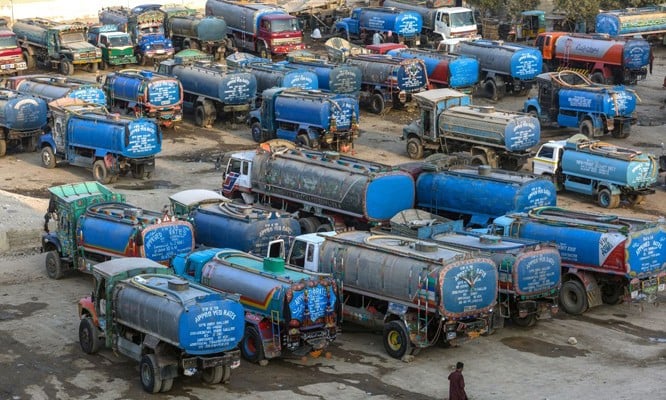
Safe drinking water is still a pipedream in Karachi -- the reasons behind the crisis are tanker mafias and poor water distribution network

May and June 2019 saw a rise in protests by Karachi citizens who demanded a decent water supply to their neighbourhoods. Roads were blocked in many localities including PIB Colony and Lyari where the residents braved the heat and raised voices for restoring proper water supply to their households. Pakistan Tehreek-e-Insaaf also led a protest at the offices of the water utility on June 14 demanding the restoration and equitable distribution of water to various areas. It is expected that this situation is likely to persist as the demand for water shall rise and erratic supply -- or the complete absence of it -- shall irritate residents.
Not too long ago, a Supreme Court-led commission thoroughly examined the water and sanitation issues in Sindh -- including Karachi. The findings were extremely dismal.
Acute shortage at the bulk supply level, increase in water thefts and leakages, institutional challenges faced by the Karachi Water and Sewerage Board (KWSB), financial handicaps experienced by the water utility, exponential rise in the operations of water tankers (especially during peak summers), run down and aging piping network, lack of a comprehensive maintenance and network rehabilitation plan for older neighbourhoods, and the inability of the water utility to attend fresh water connection needs in suburbs and elsewhere are some core mentions.
The commission’s findings have helped place some of the pressing water issues in the current perspective. But there are some other important matters that have an enormous bearing on Karachi’s water affairs. Unless they are not highlighted and put in appropriate focus, little improvement can be expected.
About half of Karachi’s population resides in densly populated suburban settlements that include Orangi, Baldia, Qasba, Korangi and Landhi. Water supply situation at the retail level is one of the worst in these localities. People purchase expensive water through tankers after suppressing other essential priorities in spending. Thus the possibility of graduating out of the poverty spiral further diminishes.
Options of access to water include erratic supply (where pipelines exist), collusion with area gangs who puncture water mains for commercial sales, boring and using semi-brackish water and purchasing tanker loads. Karachi annually adds more than 0.6 million people to its tally but bulk water supply does not scale up.
For the past many years, supply is static at 550 million gallons per day (mgd) against a standing demand of 1.1 billion (mgd). Less than one third of the consumers pay the water bill, which is charged at an extremely low tariff. Biggest defaulters of KWSB include federal and provincial government departments that owe the utility over Rs20 billion.
The culture of non-payment has now trickled down to the ordinary consumer level. A study by this author revealed that many folks considered urban piped water as a gift of nature that does not need any monetary compensation. Some time ago, Managing Director of KWSB was reported to have complained that 95 percent of over 200,000 mosques and imam bargahs do not pay their bills. Surprisingly, the water tanker operators are able to recover much of the revenue for over 50,000 tanker trips estimated to be done every day. Most of these transactions are informal and cash based in nature, proceeds of which are believed to be shared amongst many layers of influential stakeholders.
Despite repeated identifications done by researchers and media reports, the water quality remains below the desired level. A sampling examination conducted to test water quality from different city locations revealed that 97 percent samples were unfit for drinking. All these samples required appropriate treatment. The middle and upper income groups either obtain bottled water or resort to filtration, ultra violet treatment devices or simply boiling. The poor neither possess awareness nor the means to make water safe for consumption. Thus when piped water gets mixed with contaminants due to different reasons, public health hazards instantly emerge, as was found in Landhi some years ago where hundreds of people were affected by gastroenteritis after using impure water.
Water supply lines at the bulk and neighbourhood level must be examined for their performance efficiency. Many of them have outlived their utility while others have been rendered defected due to organised thefts or gradual wear and tear. This exercise must be done after an assessment done by a third party technical enterprise to obtain a comprehensive picture.
A rehabilitation programme may be prepared to fix the leaking pipes and joints with priority assigned to remote residential neighbourhoods. Water supply standards and specifications must also be revised as per the current lifestyles and densification of neighbourhoods. It is also important to re-visit the status of revenue collection from retail and bulk consumers of the service.
While water through tankers costs around Rs3 per gallon, the normal bills consumers receive are ten times lower than this value. A realistic tariff must be worked out which must be backed by solid financial working to enable the utility sustain the operation and maintenance of the network. A ‘willingness to pay’ also needs to be promoted through specifically devised campaigns for water consumers, many of whom simply refuse to pay the bills.
A research conducted by this author informed that majority of users believed that water is a gift of nature and paying for its supply is not a binding responsibility. Similarly, in Orangi, Baldia and Surjani Town, people constructed community tanks (awami or people’s reservoirs) some years ago for collectively managing and distributing water to less privileged households. These tanks were constructed on public spaces and had provisions of storing about 2000 to 4000 gallons of water. Once water tankers, purchased through community pooled funds were procured, it was distributed through canisters under joint management of the area people.
Efforts must be made to revive this option which became ineffective several years ago when people were made to believe that piped water will soon be available in abundance.